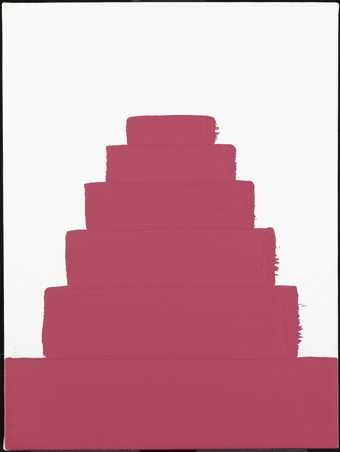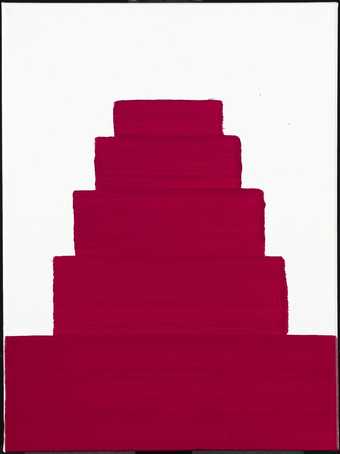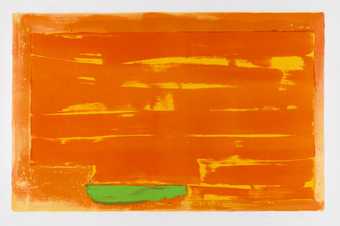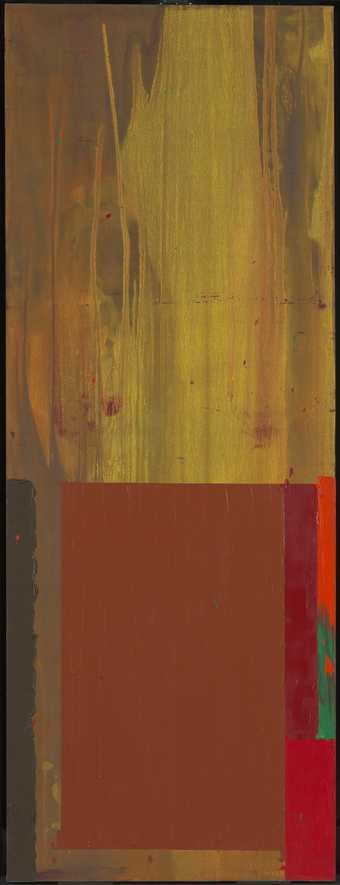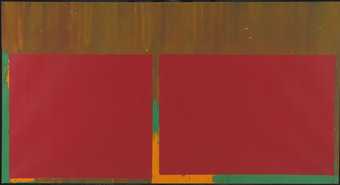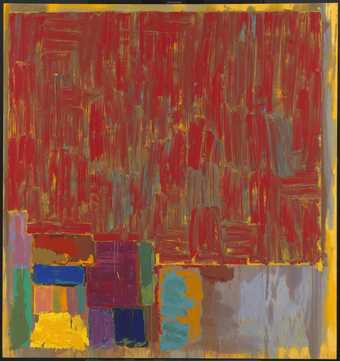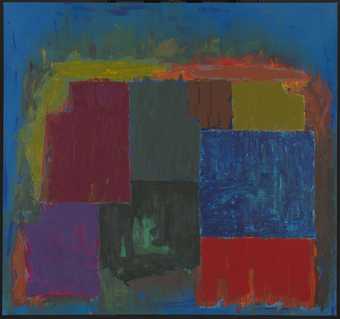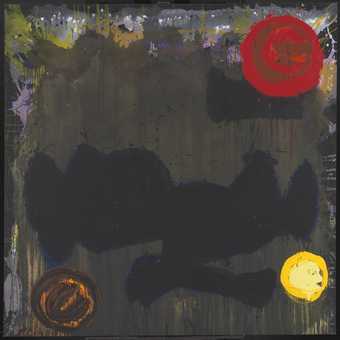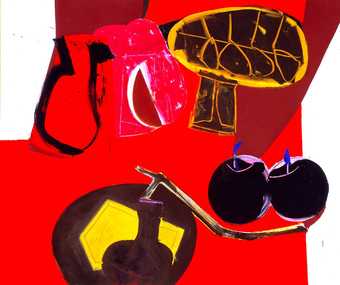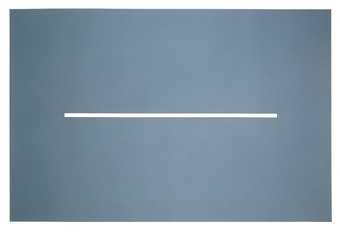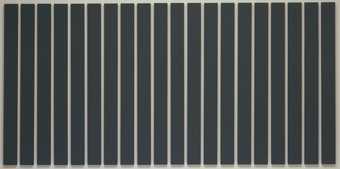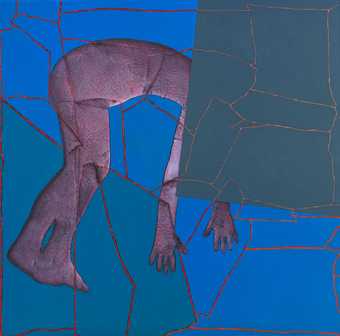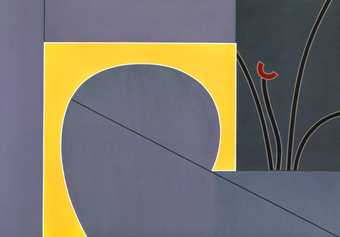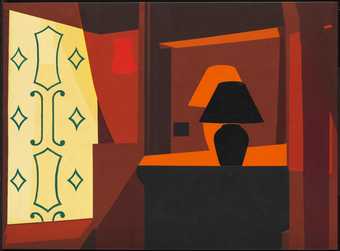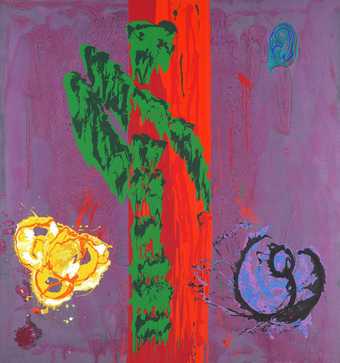
Not on display
- Artist
- John Hoyland 1934–2011
- Medium
- Acrylic paint on canvas
- Dimensions
- Support: 1530 × 1399 mm
- Collection
- Tate
- Acquisition
- Presented by the artist’s estate 2018
- Reference
- T15067
Summary
Hoyland never maintained a distinct signature style, moving from thinly painted pictures, where the colour almost stains the canvas, to veils of colour that become thicker and more encrusted by the 1970s. By the late 1980s blocks of colour (sometimes given body with Polyfilla) were discarded in favour of calligraphic abstract signs, thickly painted on thin grounds of colour. Writing in 2006, the critic Mel Gooding described Hoyland’s approach to painting:
Hoyland has persisted in his progress towards an extreme abstract art of declarative pyrotechnics and sensuous generosities. In an age of anxiety for painters, in which his contemporaries have been haunted by the questions of what to paint, how to paint, or whether to paint at all, Hoyland has suffered no doubts about his vocation: he paints because that is his chosen means to the poetic expression of a life.
(Gooding 2006, p.157.)
However, despite his allegiance to a form of abstraction that can be typified by the work of painters that he admired, such as the American abstract expressionists Mark Rothko (1903–1970) or Hans Hofmann (1880–1966), Hoyland’s attachment to the idea of abstraction was not as clear cut as Gooding here suggests. This can be seen in a group of paintings from the mid-1990s, such as Story from Nature 12.9.96 (Tate T15066), a period in which his painting underwent profound change and witnessed the introduction of motifs that – however submerged – made reference to nature.
In the Mysteries paintings, the emphatic verticality of pictures such as Story from Nature was dispensed with in favour of a return to centralised forms away from the edges of the painting, closer to the compositions of Hoyland’s work of the late 1980s. However, these late paintings, in their technique, extend the spatial depths and ambiguities of the Bali paintings through the creation of a myriad of surface marks that appear to co-exist alongside a centralised dark plunging space that is the result of glazes of opaque, matte, gloss, metallic and translucent paint laid over a dark ground. These all layer together to create otherworldly surfaces and spaces that become tangible through the pooling of bright colour. Unlike Hoyland’s works made since the late 1980s, the compositions of which were worked out through drawing, these last paintings communicate space and volume that is purely painted. When they were first exhibited at the Beaux Arts Gallery, London, shortly before Hoyland’s death, the catalogue included a quote by Hoyland about Rothko, whom he said ‘painted zones of reality … Independent of signs, space existed before the beginning of form but retaining feeling as a living reality.’ (In John Hoyland: Mysteries, exhibition catalogue, Beaux Arts Gallery, London 2011.) Smaller than his usual paintings – a practical result of a recent heart operation – the Mysteries express a sense of spirituality alongside intimations of mortality, feelings previously absent in a lifelong approach to abstraction that had been driven by the expression of a love of life and a freedom from being bound by accepted taste or convention.
Further reading
Mel Gooding, John Hoyland, London 2006.
Andrew Lambirth, John Hoyland, Scatter the Devils, Norwich 2009.
Andrew Wilson
April 2018
Does this text contain inaccurate information or language that you feel we should improve or change? We would like to hear from you.
Display caption
In 2008 Hoyland revealed that ‘I like to try and make these pictures paint themselves. The less you impose, the fresher it is. Painting is a kind of alchemy.’ Though his painting shifted in appearance throughout his life, Hoyland consistently approached it as an expression of his engagement with life. Smaller than his usual paintings – a practical result of recent heart surgery – the Mysteries communicate a sense of spirituality combined with an awareness of mortality. This mood contrasts with Hoyland’s earlier work which he infused with a love of life and freedom.
Gallery label, October 2019
Does this text contain inaccurate information or language that you feel we should improve or change? We would like to hear from you.
You might like
-
Martin Creed Work No. 1104
2011 -
Martin Creed Work No. 1105
2011 -
John Hoyland Untitled
1976 -
John Hoyland 25. 4. 69
1969 -
John Hoyland 17. 3. 69
1969 -
John Hoyland Saracen
1977 -
John Hoyland North Sound
1979 -
John Hoyland Gadal 10.11.86
1986 -
Brian Fielding Cherry
1986 -
Alan Charlton Single Horizontal Slot Painting
1991 -
Alan Charlton 20 Part Line Painting
1991 -
Derrick Greaves Falling I
1984–5,1992–3 -
Derrick Greaves Canal
1997 -
Patrick Caulfield Braque Curtain
2005 -
John Hoyland Story From Nature 12.9.96
1996

